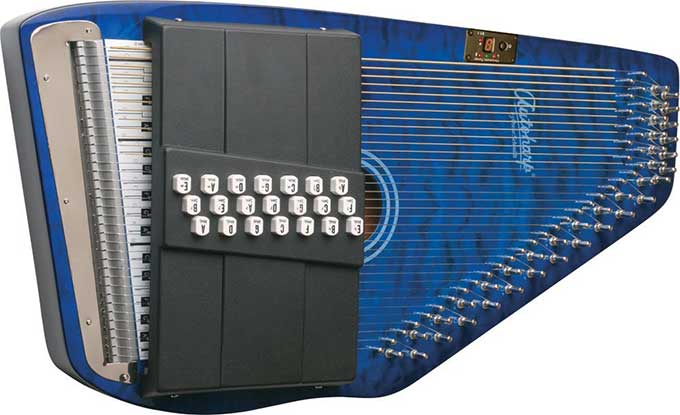Autoharp

Music made easier
There are many studies that demonstrate the value of playing a musical instrument, beyond the music itself. Playing music is excellent mental exercise: simultaneously engaging your brain’s motor, memory, sensory, visual, aural, emotional, and even verbal centers (if you’re singing as well). Playing a musical instrument during adulthood is associated with reduced risk of cognitive impairment and dementia; it can significantly reduces symptoms of depression, anxiety, and stress. It’s been shown to help sharpen concentration skills and increase memory capacity; it’s one of the most challenging and beneficial activities a human can undertake.
All excellent reasons to play an instrument… but musically, Iʼm lazy. Very lazy. Though I love music, I had never mastered any instrument, and practicing was always a chore, even with instruments that I loved. Iʼve tried clarinet, recorder, guitar, mandolin, mountain dulcimer and folk harp, but even when I managed to reach some level of competency, I couldnʼt sing and play correctly at the same time. I felt like my brain needed a RAM upgrade.
And then I borrowed an autoharp. Right away, I could strum it on my lap and sing along, without screwing up the chords. I was playing, I was singing, I was stunned — I was hooked. Practicing wasnʼt a chore; now I had to force myself to put the thing down after playing and singing for 5 hours straight into the wee hours of the night. The point is, almost anybody with an elementary sense of rhythm can make music that sounds good from an autoharp, from the very start…and improve over time, as much as they are inclined to.
It’s so, so very much easier than playing a guitar, though I’ll admit, the tuning is a tad tedious (36 strings). But the chord bars on an autoharp vastly decrease your chances of hitting the wrong note, and there are none of those cramp-inducing finger contortions required for playing guitar. Just hold down a bar, and strum — and there’s your chord! You can take an autoharp as far as you want. In a few hours you can play well enough to chord along with your favorite tunes. In weeks, you can learn to play the harp upright, and pick out tunes or harmonies. Eventually, who knows? You might be attending festivals, entering an autoharp contest, or playing for yourself at home, happy as a clam.
Autoharps can be played in myriad styles: “old-timey” (ala Carter Family, see video below), bluesy, folky, lyrical, Celtic, rocking, classical. They lend themselves to almost any kind of music you can think of. And the autoharp community is remarkably welcoming and inclusive, in my experience. Even the “superstars” of the autoharp are willing to teach beginners. I recently attended “Seattle Autoharp Week” where participants, in small groups, took lessons from some of the best ʻharpists in the world. (Imagine a beginning guitar class taught by Eric Clapton.)
Many people donʼt realize how beautiful an autoharp can sound; if theyʼve heard one at all, chances are theyʼve heard one out of tune — ghastly. Autoharps do need to be carefully tuned, and this does take time; I recommend getting a ʻharp with fine tuners if possible, as well as a good chromatic tuner such as the clip-on Snark HZ-1 (or a tuning app such as iStroboSoft). Fine tuners arenʼt cheap (adds about $100), but theyʼll save you much time and frustration. Beware of old autoharps that have sat in a closet for years: sometimes their sound quality deteriorates if they are neglected and improperly stored; strings may be “dead” and probably also need replacing for optimal sound. There are some “autoharp doctors” around who can rejuvenate many of the old autoharps — or tell you if that ʻharp is probably a lost cause.
New mass-manufactured ʻharps should preferably be checked and set up by an autoharp expert — not all new ʻharps are ready-to-play straight from the factory.
Autoharp prices range from zip (check your local Freecycle or Craigʼs List page) to over $2,000 for a custom-made luthier ‘harp. You can pick up a 21-bar Oscar Schmidt with fine tuners that has been set up by an autoharp expert for about $400-$450. I bought an Evoharp (lighter, prettier, handmade, available in right or left-handed models) for $850.
See the Autoharp Page for luthier links; if youʼre the adventurous type, check out eBay. Music isn’t just something you play—it’s something you do. The Autoharp Page: Links to autoharp makers, publications, recordings, festivals, artists, teachers, hints and tips, and especially: the Cyberpluckers, an online forum where you can ask any autoharping question (as long as you check out the FAQs first). Beginners very welcome.
Beginning Autoharp with Evo Bluestein DVD I donʼt learn music well from books, but I could follow Evo just fine, and pause him, rewind, repeat until I got the lesson down. Very helpful to be able to see what youʼre supposed to be doing, as well.
01/20/17Oscar Schmidt OS21CQTBL Autoharp ($358)









